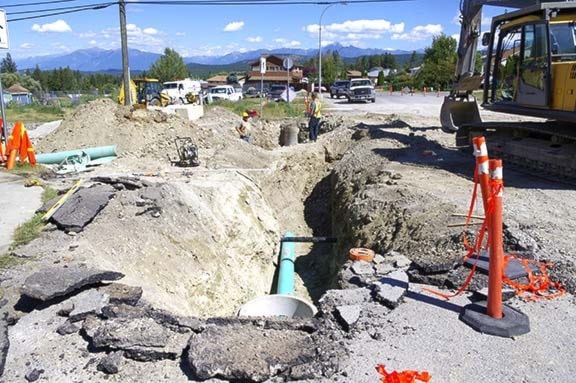Cranbrook's roads are in such poor condition that the city would need to spend $59 million next year to bring the roadway system up to an acceptable condition.
This video shows the condition of 4th Avenue South's road bed just below the asphalt before road repairs this summer.
On top of that, the city's remaining infrastructure — including water, sewer, stormwater, buildings and so on — needs an investment of $48 million for it to be up to scratch, meaning the city has an infrastructure deficit of $107 million.
That figure is so unreachable that the city's director of engineering Jamie Hodge says council may have to consider lowering levels of service — for instance, reducing water pressure, not having sidewalks, and cutting back on transit services.
"We are going to have to look at strategically reducing services and accepting fewer services from our authorities as time goes on," Hodge told city council in a special presentation on Monday, November 21.
Unless Cranbrook takes action, parts of the city may become unlivable, he went on.
“It is going to take us a long time to deal with this deficit, make no doubt about it,” said Hodge. “If we don’t somehow or another get control of it, then I question whether Cranbrook will continue to be a sustainable community if parts of it are not livable because the services just don’t work.”
While Cranbrook owns infrastructure valued at $660,460,000, the city has a $106,655,000 backlog on maintenance, repair and renewal for its infrastructure.
Of that $107 million, $58,691,000 (55 per cent) needs to be spent on our roadway system. The wastewater system needs $10,236,000 to be up to scratch, the water system requires $8,327,000, storm water needs $6,310,000, and non-linear infrastructure such as buildings and parks needs $23,100,000.
On top of that, even if Cranbrook could come up with $107 million to do those repairs, the city would still need to put aside $15.3 million every year to keep the infrastructure at an acceptable level.
In 2012, city council budgeted just $2.8 million for linear infrastructure.
So, if Cranbrook keeps spending on infrastructure at the same rate as it is now plus inflation, after 10 years council would need to add $53 million to the $107 million needed for repairs.
Cranbrook’s roadway system is in the worst condition of all of the linear infrastructure, with an expected remaining life of 31 per cent.
The city owns 158 kilometres of roads, valued at about $178 million. To maintain that roadway system would cost $4.2 million each year.
But Hodge said Cranbrook is not alone in dealing with a large infrastructure deficit.
“Our community is absolutely average with communities large and small across the country,” said Hodge. “Without sustained renewal funding from other levels of government, it’s all our tax dollars and you know how little of the tax dollar you have any control over,” he told council.
However, Hodge said the answer is not increasing property taxes, either.
“The whole objective is not to spend a great deal more than we already spend. We are tapped out as a community — the taxpayer can’t pay more. We will have to use other ways of managing it,” he said, adding that he doesn’t mean property tax rates should be frozen indefinitely.
“Fortunately, I believe that if we act we can stall this challenge. It will take commitment and time. The old adage is: how do you eat an elephant? One bite at a time,” said Hodge.
He presented a plan to deal with the infrastructure deficit. The city should hold open houses to present “infrastructure report cards” to the community and pick up anecdotal feedback. The city should create a staff committee with representatives of each department that would set priorities for infrastructure projects, in collaboration with a new community taskforce on the issue. Hodge recommended the city hire a new staff member to assess infrastructure investment and conduct risk analysis. Finally, he urged council to keep an open mind to financial reform.
“I’m not exactly sure what form that should take, but it would be safe to say our existing models don’t measure up to today’s demands. They are going to get less relevant as time goes on,” said Hodge.
Council welcomed the report, but many admitted the presentation was frightening.
“It’s very serious,” said Mayor Wayne Stetski. “There are some tough choices ahead.”
Councillor Gerry Warner said making up the deficit could mean big changes for Cranbrook.
“If at this table we did nothing but deal with infrastructure, it would probably be too much. We are going to go down a road that is really going to change the lifestyle of this community. Man, this is serious,” said Warner.
But other councillors said that at least it is identifying the problem.
“Those are some pretty daunting numbers but acknowledging what they are is the first step towards a long term solution,” said Councillor Bob Whetham.
Councillor Diana J. Scott agreed: “It may not look too pretty, but it’s a way to not hide our head in the sand, to say this is where we are and build towards the future.”
